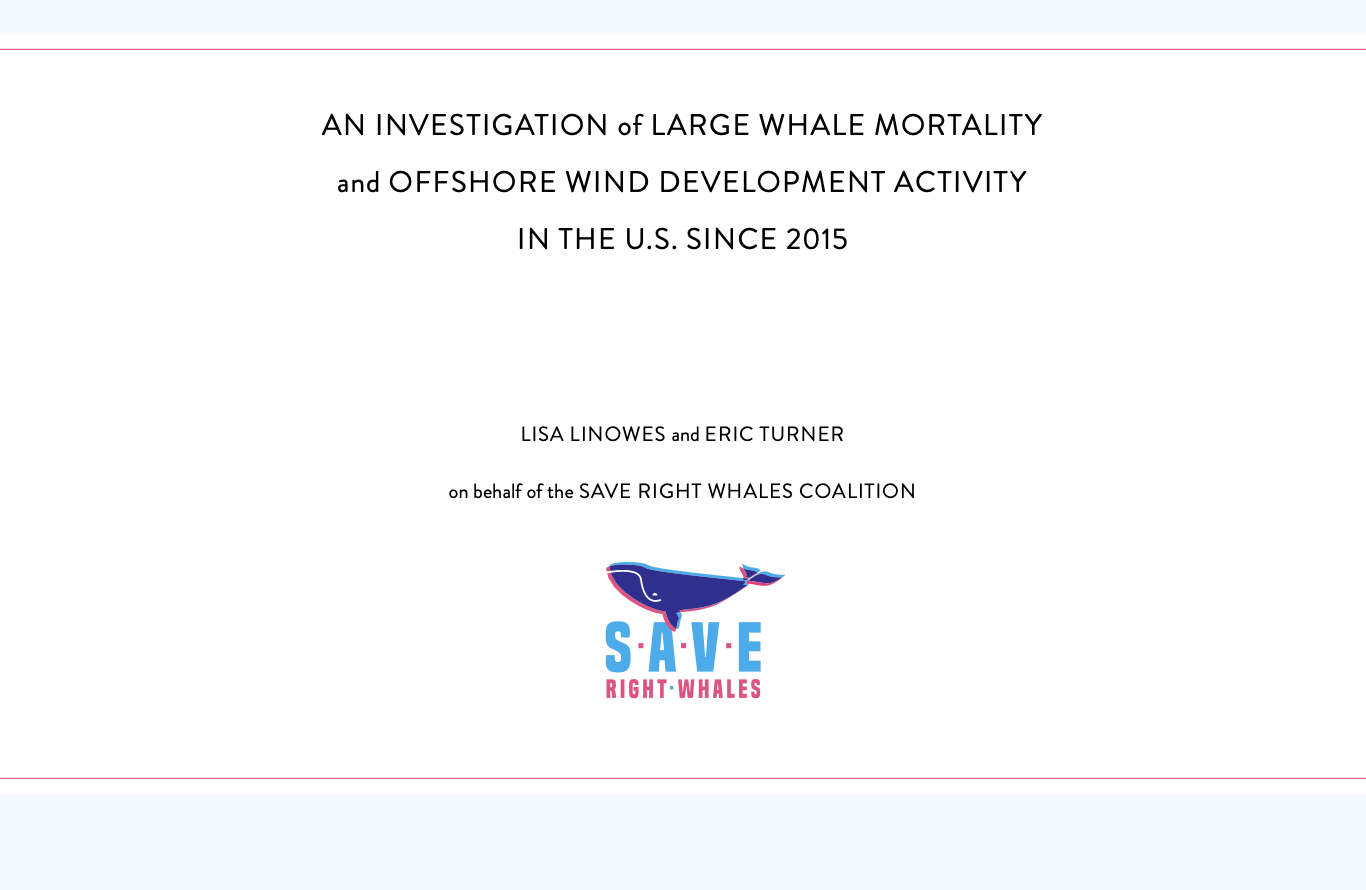Wind Industry Activity Strongly Correlated With Whale Deaths, New Study Finds
“An Investigation of Large Whale Mortality and Offshore Wind Development Activity in the U.S. Since 2015.”
LISA LINOWES and ERIC TURNER
on behalf of the SAVE RIGHT WHALES COALITION
Since 2016, the National Oceanic and Atmospheric Administration (NOAA) has declared three Unusual Mortality Events (UME) involving large whale species in the Atlantic Ocean. These are specifically the Atlantic humpback whale UME in 2017, the North Atlantic right whale (NARW) UME in 2017, and the Atlantic minke
whale UME in 2018. The UMEs for the humpback and minke whales include deaths in 2016 and 2017, respectively.
The beginning of these declarations coincides with increased offshore wind (OSW) vessel activity in waters where the whale deaths were observed. Prior to the closing months of 2015, no notable OSW survey, construction, or maintenance vessel traffic existed in the Atlantic Ocean.1 Commencing with the preparation and construction of five wind turbines off the southeast coast of Block Island, significant and frequently intense OSW vessel traffic has been observed.
This report documents geographic and volume-based evidence of marine mammal deaths that correlate directly to OSW vessel activity from 2016 forward. Using maps of whale deaths and OSW vessel tracks, the authors endeavor to graphically display an increase in mortality against OSW vessel activity.
FINDINGS
This study identified a direct correlation between increased OSW vessel activity and whale mortality. Key findings of the study include:
a) A connection between OSW vessel activity within ocean areas and whale deaths has been an ongoing concern in the United States since the 5-turbine Block Island wind facility was under construction in 2016. OSW developers employ high-resolution geophysical (HRG) equipment that uses sonar to map the seabed in the lease areas. Sound from sonar surveys and wind turbine pile driving is recognized as harmful to marine mammals.
b) Research and press accounts from the United Kingdom and Europe dating back more than a decade suggest whales and other marine mammals experienced displacement and mortality events in the North Sea related to offshore wind development. Scientific evidence detailing the impacts of OSW on marine life continues to be limited. Where studies have been performed, it is not clear the outcomes
can be applied to environmental conditions of the coasts of the United States. Testimonies from the United Kingdom show that resolving the climate crisis has been the priority for the government over concerns related to wildlife and environmental impacts.
c) Ocean vessel tracks in the Atlantic prior to 2016 show that very little marine traffic beyond fishing and pleasure boats occurred within the wind lease areas. Annual aggregate vessel tracks within established shipping lanes and in areas close to shore appear relatively constant over the period from 2015 to 2023 with nominal changes year-over-year. The change in vessel activity after 2015 coincided with the U.S. Bureau of Ocean Energy Management (BOEM) finalizing lease agreements with OSW developers. Traffic within the lease areas materially increased.
d) In the period from 2007 to 2023, 60% of total whale mortality along the east coast from Maine to North Carolina occurred after 2015 (n=470 of 788 whales). This represents a 48% increase in whale deaths overall. In several states where OSW activity was significant, the percent increase in mortality was well over 60% (Tables 2 and 3). The increase in whale deaths and NOAA’s declarations of unusual mortality events correlate directly with the increase in OSW activities within federally leased areas.
e) Vessel track data show whale deaths occurring within the same timeframe as the OSW sonar surveys and in proximity to the sonar activity. As the amount of OSW activity increased within an area, so did whale deaths. Shortly after pile driving to install wind turbines was initiated in late spring 2023 for the Vineyard Wind 1 and South Fork Wind facilities, additional whale deaths were observed in southern New England.
f) Using commercially and publicly available tools and data, this investigation found a positive relationship between OSW vessel activity and whale mortality. Additional in-depth investigations are necessary to determine if there is a causal connection between OSW activity and the increase in whale mortality.

